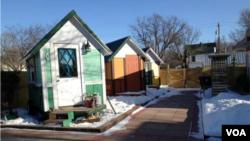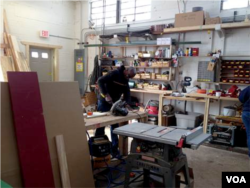In what looks like an ordinary woodshop in Madison, Wisconsin, filled with table saws, screwdrivers and more screws and nails than you could count, transformative work is underway.
This space, operated and owned by a nonprofit called Occupy Madison Incorporated, is part of a village of small houses built to order for - and by - homeless individuals in Wisconsin's capital city.
Luca Clemente has been involved with the group almost since it began in 2011, when residents organized Occupy Madison in solidarity with other activists protesting societal inequality. That winter, 60 to 80 people were sleeping in tents each night at the group’s encampment in an abandoned car lot.
Clemente remembers that it didn't take long before they began to shift their focus from political activism to the much more grounded issue of homelessness.
"We realized that we had made a lot of real connections with people who were going to have nowhere to go,” he said. “We began to notice, as we had meetings each week, that there were more and more homeless people, and over time the whole flavor changed from a place that was occupied by political activists to a city of people who had no place else to go."
A search for a permanent solution
After Occupy's first hard Wisconsin winter, Madison’s mayor made it clear that the encampment would have to dissolve. Clemente said the group had other ideas. Instead of disbanding, they kept moving.
"We had people stay at campsites, we ended up occupying parks, but everywhere we went we were told that it was illegal, which we knew,” he said. “If you don’t have any place to go and it’s after dark and you want to sleep, you’re breaking the law."
So in 2013, the Occupy activists incorporated as a nonprofit with the intention of buying a parcel of land on which to build small homes and an eco-village. Heidi Wegleitner, a local county supervisor, worked with them through the transition. She remembers the hard work Occupy had to do to satisfy both the neighbors and government officials.
"There’s a lot of stigma around homeless folks," she pointed out, "there was really a lot of work that Occupy had to do to mythbust around their project, because it was so new and innovative."
Homelessness is a critical issue in Madison. Between the thousands of people who sleep on the streets or in shelters, and those classified as “housing insecure,” city and county resources for housing are incredibly competitive. Moreover, Wegleitner said, the resources that do exist can be alienating to many of those who depend on them.
"None of the shelters, none of the places that were intended to serve homeless people, were really built to be welcoming, or accommodating, or help someone recover from trauma, or be cared for who might have health problems or whatever,” she said. “So the shelter system is very strained."
A nurturing alternative for the homeless
Paul Mugambi Muthamia stays in the shelters, but is working hard to get a tiny house. He has lived in Madison since the late nineties and appreciates the way the organization treats the homeless.
"Your input, your ideas are of just as much importance as any board member," he said happily. "It’s like honey, I’m a bee!"
Occupy Madison’s houses are being built by the people who hope to move into them. Muthamia is excited to put in his hours.
"I’m in my first hundred hours and I think it requires 500 hours to be able to occupy a house,” he said. “We’re a group of rebels, doing something really effectual, and radical, extremely radical! People working together is a radical notion, this is a very selfish society we’re in, it’s about looking pretty, but here it’s about all of us looking pretty."
The quiet village certainly does look pretty, with the three houses already finished sitting side by side. A porch light shines above the door of the green one on the left - its occupants are home.









